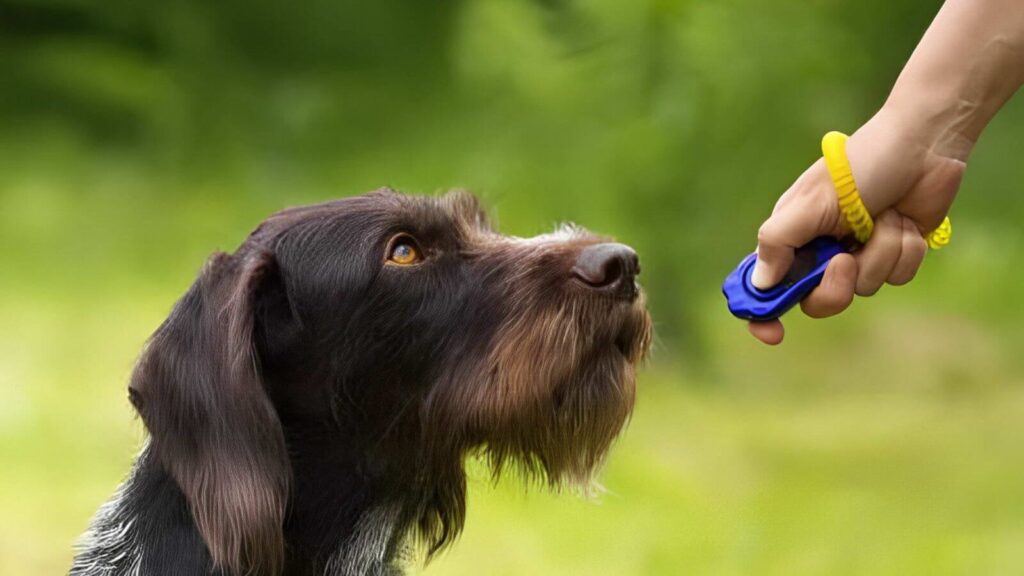
“Clicker training” is the popular term for the training or teaching method based on what we know about how living organisms learn. Research has shown that any creature—whether a dog, cat, dolphin, parrot, fish, horse, llama, or person—is more likely to learn and repeat actions that result in consequences it desires and enjoys. So clicker trainers provide consequences desired by their animal in exchange for actions or behaviors desired by their trainers. We call these consequences “rewards” and we call the process “reinforcement.” Clicker training, therefore, is a positive reinforcement-based system of training.
Why is clicker training effective?
When an animal intentionally performs a behavior to bring about a desired consequence, they are learning in a way that researchers call “operant conditioning.” Animals (and people) may also associate an action, event, place, person, or object with a consequence, whether pleasant or unpleasant. When a certain event or environment repeatedly pairs with a particular consequence, it creates a stronger association. We call this type of learning “classical conditioning,” which shapes reflexive or automatic behavior, not intentional behavior.
While clicker training initially employs classical conditioning, it quickly becomes operant conditioning. This occurs as soon as the animal intentionally repeats an action in order to earn a reward. Training through operant conditioning results in purposeful behavior, while training through classical conditioning results in habitual behavior. The difference between an animal that behaves with purpose, rather than by habit, is vast. Clicker trained or operantly conditioned animals try to learn new behaviors. They remember behaviors even years later because they were aware of them as they learned them, rather than acquiring them without awareness. They develop confidence because they have control over the consequences of their actions and are enthusiastic because they expect those consequences to be pleasurable.
Why use a clicker?
Clicker training differs from other reward-based methods because it tells the animal exactly which behavior earned the reward. Trainers communicate this information using a distinct sound—the click—which happens at the same time as the desired behavior. The reward follows. Without hearing a click during an action, an animal may not connect the reward with that action. Or, the animal may associate the reward with another, unwanted action. With the click, a trainer can precisely “mark” behavior so that the animal knows exactly what it was doing. That’s why clicker trainers call the click an “event marker.” The click also bridges or connects the behavior and its reward, we call this a “bridging signal.”
Why use the click? Why not just a word?
A click is more powerful for training than a spoken word because it is not a sound heard by the animal in other circumstances. It means one thing only: a reward is coming because of what you did when you heard the click. You can produce it instantly and at the exact moment a behavior occurs. Even a very quick and subtle behavior, the twitch of an ear for example, can be clicked.
Unlike our voices, which can say the same word in different ways, and so express different emotions or meanings each time, the click sounds the same every time it is heard; its meaning never varies. Humans are highly verbal creatures, but our pets are not. It can be difficult for them to pick out a single word from the stream of meaningless words they hear us speak every day. The click’s meaning, however, is always clear. It is always directed at the animal, and it is always good news. The clarity with which a click enables trainers to communicate with their animals has a profound effect on their relationships. Their level of interaction increases, and trainer and animal become more interesting and fun for each other.
How does clicker training work?
The trainer clicks at the moment the behavior occurs: the horse raises its hoof, the trainer clicks simultaneously. The dog sits, the trainer clicks. Clicking is like taking a picture of the behavior the trainer wishes to reinforce. After “taking the picture,” the trainer gives the animal something it likes. This is usually a small piece of food or sometimes play or petting.
Very soon (sometimes within two or three clicks), an animal will associate the sound of the click with something it likes: the reward. Since it wishes to repeat that pleasurable experience, it will repeat the action it was doing when it heard the click
You can train any behavior with any animal following these three simple steps:
1. Get the behavior.
2. Mark the behavior.
3. Reinforce the behavior.
How do clicker trainers ask for behaviors?
Clicker trainers differ from traditional trainers in that they wait until the behavior is well understood by the animal before using a command or “cue.” A cue is the name of a behavior, such as “sit,” or a hand movement or other clear signal. Until the animal knows what the behavior is, any name for it would be meaningless. When the animal has been clicked several times for a behavior, and then confidently repeats the behavior, showing that it knows exactly what earns it a click and a reward, it is ready to learn the name of the behavior. Clicker trainers call this “introducing the cue.”
To teach the animal the name of the behavior, or the cue, the trainer says or signals the cue before the animal repeats the behavior. After several repetitions, the trainer begins to click and reward when the animal does the behavior, but only after the cue is given. No click is given if the animal does the behavior without being given the cue first. The animal quickly learns to listen or watch for its cue, which tells it: If you do this behavior now, you will get a click and earn a reward.
What if the animal does not obey the cue?
Clicker trained animals want to perform behaviors for which they have been rewarded in the past. If they understand the meaning of the cue and desire the reward, they will perform the behavior. If they do not perform the behavior, clicker trainers do not assume that the animal is “disobeying.” Instead the trainer asks the following questions:
- Does the animal know the meaning of the cue?
- Does the animal understand the cue in the environment where you first taught it but not in the new environment where you’re using it?
- Is the reward for doing the behavior sufficiently desired by the animal.
After answering those questions, the clicker trainer revises the training process to ensure the animal knows the meaning of the cue in all environments, regardless of distractions, and feels rewarded for the behavior.
Why don’t clicker trainers use punishment as well as rewards?
A consequence of any behavior can be unpleasant as well as pleasant. So why shouldn’t punishments follow unwanted behaviors, just as rewards follow wanted behaviors? Research tells us that punishment may decrease the frequency of an unwanted behavior, but usually results in producing another unwanted behavior. The results of punishment as a training method are difficult to predict and to control. Punishment is not usually identified with an event marker. It almost always comes after the event and rarely connects with a specific behavior. In the animal’s perception, punishment is a random, meaningless event.
It is, therefore, less effective than the combined use of an event marker and positive reinforcement in changing behavior. Clicker trainers also feel that their relationships with their animals are stronger and more rewarding when they focus on the positive rather than the negative. Like the difference between an animal behaving with intention rather than by habit, the difference in attitude and enthusiasm between an animal that works to earn rewards rather than to avoid punishment is vast.
Can you use clicker training to get rid of behavior?
Clicker trainers allow unwanted behaviors to disappear through lack of reinforcement. If a behavior is not rewarding to the animal, eventually it will disappear. If an unwanted behavior persists, clicker trainers study the behavior to understand why it is reinforcing to the animal. Sometimes the behavior reinforces itself: a barking dog is less bored than a quiet dog. The barking is its own reward. The clicker trainer provides this dog with an alternate wanted behavior to replace the unwanted behavior. The bored dog may simply need more activity. Or perhaps quiet resting for longer and longer periods can become a
rewarded behavior. Then the clicker trainer would teach the dog a cue for “silence.”
Do you need to use clickers and treats for every behavior, forever?
No. Once the animal learns the behavior on cue, there’s usually no need to click, as the animal understands the behavior. Clicker trainers maintain the behavior by replacing specially good treats with occasional and less intensive rewards including a pat or praise. Real-life rewards also maintain learned cues and behaviors. For example, if your dog sits quietly at the door, reward them by opening the door so they can go for a walk. Clicker trainers then save clicks and treats for the next new thing they want to train.
Can you use clicker training with any animal?
Yes. Dolphin trainers first widely used operant conditioning because they needed a way to teach behaviors without physical force. Today, trainers successfully use this method with animals of all sizes and species. Clicker trainers who learn the underlying principles have at their disposal a powerful set of tools that enable them to analyze behaviors, modify existing methods for individual animals, and create new methods where none previously existed. This flexibility lets trainers reinvent clicker training tools to work in a range of situations and for an infinite variety of animals. Athletes, dancers, skaters, and others also apply these same principles to their training. Called “TAGteach,” this form of training uses a click as a marker signal to teach precise physical motions quickly, accurately, and positively.
Is clicker training a training method or a philosophy?
People often feel surprised by the enthusiasm and dedication clicker trainers show for their method. Many trainers start learning to click as a way to train their dog but soon realize they can apply the fundamental principles of clicker training to other areas of their lives. Changing one’s focus from the negative to the positive can certainly be a life-changing event.
Copyright 2005 Karen Pryor Clicker training and Sunshine Books, Inc.
phone: 781-398-0754 — website: www.clickertraining.com
